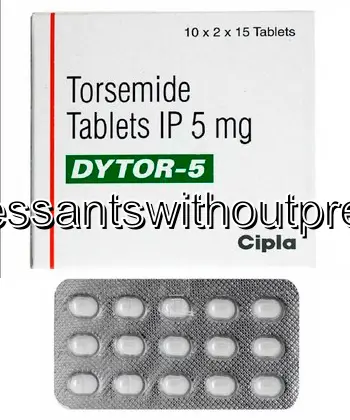| Package | Dosage | Price | Price per Dose | |
|---|---|---|---|---|
| Dosage: 10mg | ||||
| 360 pill | 10mg | $322.17 | $0.89 | |
| 180 pill | 10mg | $172.24 | $0.96 | |
| 120 pill | 10mg | $156.29 | $1.31 | |
| 90 pill | 10mg | $135.56 | $1.50 | |
| 60 pill | 10mg | $98.33 | $1.64 | |
| 30 pill | 10mg | $79.89 | $2.66 | |
| Dosage: 20mg | ||||
| 360 pill | 20mg | $470.51 | $1.31 | |
| 180 pill | 20mg | $266.35 | $1.48 | |
| 120 pill | 20mg | $199.36 | $1.66 | |
| 90 pill | 20mg | $164.27 | $1.82 | |
| 60 pill | 20mg | $130.77 | $2.19 | |
| 30 pill | 20mg | $95.68 | $3.19 | |

Torasemide Description
Overview of Torasemide
Torasemide is a potent diuretic medication commonly used to treat conditions related to fluid retention, such as edema associated with heart failure, liver cirrhosis, or kidney disease. It belongs to the class of loop diuretics, which work by acting on the kidneys to increase urine production. This helps reduce excess fluid in the body, alleviating symptoms like swelling and shortness of breath. Due to its effectiveness, Torasemide is often preferred over some other diuretics because it provides a longer duration of action and tends to have fewer side effects in certain patients.
Mechanism of Action
The primary action of Torasemide occurs in the loop of Henle within the nephron of the kidney. It inhibits the reabsorption of sodium, chloride, and potassium ions, which leads to an increased excretion of these electrolytes along with water. This results in a reduction of blood volume and decreased preload on the heart, making it especially beneficial for managing congestive heart failure. Unlike some other diuretics, Torasemide has a relatively high bioavailability, ensuring consistent and predictable therapeutic effects.
Usage and Dosage
This medication must be taken exactly as prescribed by a healthcare professional. The dosage depends on the severity of the condition and the patient’s response. Usually, treatment begins with a low dose, which may be gradually increased if necessary. It is important to monitor electrolyte levels and kidney function during therapy, as these can be affected by diuretic use. Patients should adhere to their medication schedule and report any side effects or unusual symptoms promptly to their doctor.
Potential Benefits
Many patients experience significant relief from symptoms when using Torasemide. It typically provides a more sustained diuretic effect with once-daily dosing, improving compliance. Its ability to effectively reduce fluid overload helps improve quality of life and physical activity levels in patients with heart failure or edema. Additionally, some studies suggest that Torasemide may have a lesser impact on certain metabolic parameters compared to other loop diuretics, making it a suitable choice for long-term management.
Possible Side Effects and Precautions
Like all medications, Torasemide can cause side effects, although not everyone experiences them. Common adverse effects include dehydration, electrolyte imbalances such as low potassium or sodium levels, dizziness, and increased urination. Less common but more serious issues can include allergic reactions, kidney dysfunction, or hearing disturbances. Patients with certain conditions, such as gout or electrolyte disturbances, should use this medication cautiously. Regular monitoring and consultation with a healthcare provider are essential to minimize risks and manage side effects effectively.
Conclusion
Torasemide is a well-established diuretic with proven efficacy in managing fluid retention related to various health conditions. Its long-lasting action and favorable side effect profile make it a valuable option for many patients. However, proper usage under medical supervision is crucial to ensure safety and effectiveness. Patients should always follow their healthcare provider’s instructions and report any concerns or adverse effects during treatment.